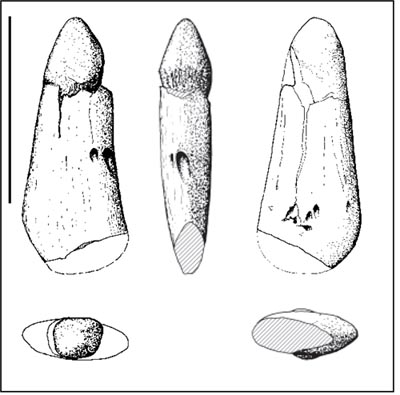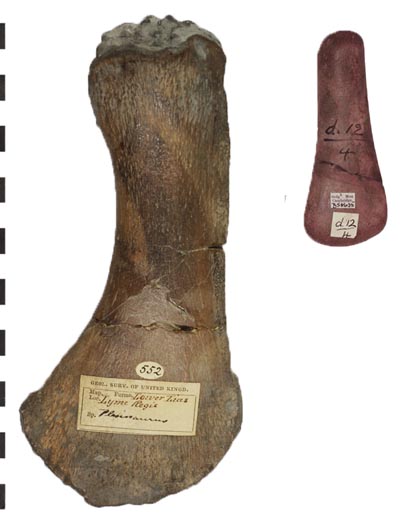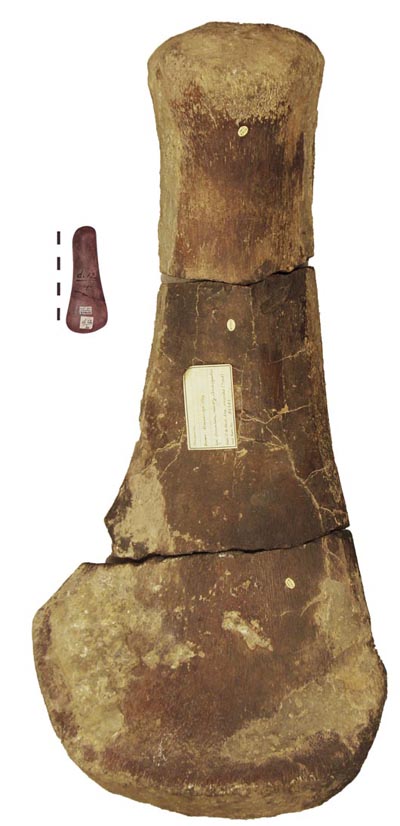I spent an enjoyable day rummaging through the drawers and cabinets of the Sedgwick Museum in Cambridge. It's a great museum, not just because of its large number of plesiosaur specimens, but because the museum itself is a museum exhibit in own right. Many thanks to the museum staff and in particular Matt Riley for their hospitality. One the specimens I came across is this one: B58635.

Quite simply, it's the smallest plesiosaur propodial I have ever seen.
What do we know about it?
As the label and a note with the specimen shows, the provenance is very uncertain. If it is from the Lower Greensand, but the locality is uncertain. The surface is polished, which is the basis on which it is considered to be derived. The most likely date is early Cretaceous, though it may be derived from older deposits.
Although worn, some aspects of the morphology of the bone can be seen. The trochanter forms a slight prominence below the head which is slightly offset from the horizontal plane of the distal end. The shaft is relatively slender and straight. There is a degree of expansion at the distal end, slightly greater posterorly than anteriorly, and although no facets for epipodials are clearly defined, the shape indicates that the posterior element was somewhat wider than the anterior. If distinct facets were present, it is probable that they have been worn away. There is a small foramen, less than a millimeter in width on the posterior edge of the shaft which may represent the epipodial artery, though its position is rather more anterior than is usually the case. From this, I have tentatively idenified the bone as the left humerus.
Is is a juvenile?
Some isolated propodials from other formations and collections are infered from the small size and general characters to be juvenile. A characteristic example is shown here (LEICT G1.2001.005, from Forrest & Oliver 2003, Fig 2), representing the smallest plesiosaur propodial recorded in the scientific literature. They are teardrop in shape. The proximal end is smoothly pointed, lacking any definition into capitulum or trochanter as is found older individuals. The bone expands to a smoothly rounded distal end lacking the facets for epipodials and other elements found in adults. There is a large foramen for the propodial artery on the posterior edge of the shaft which is greatly reduced or completely lacking in more adult individuals. In some cases there is a pair of foraminae, the more posterior of which is substantially larger.

The overall morphology of B58635 is more typical of adult propodials than those of juveniles. The epipodial arterial foramen is greatly reduced or lacking. From this I have concluded that this is from a young adult rather than a juvenile. Although a little longer overal than LEICT G1.2001.005 (84.5 v. 78 mm), its greater ontogentic age supports the conclusion that it is from a smaller taxon.
How does it compare to other plesiosaurs?
This shows B58635 at the same scale as the humerus of Plesiosaurus dolichodeirus (BGS 552) which is 190mm in overall length. P. dolichoderius was a small plesiosaur around 2.5 to 3 meters in length.

...and to be utterly ridiculous, here it is compared to a really big plesiosaur, Pliosaurus:

If we can scale reliably from other taxa, this makes the length of this young adult plesiosaur a little over a meter. It may be a bit more if it was a long-necked morphotype, or less if it is of the pliosaurian morphotype. Either way, it was tiny.
It just shows that some of the most interesting specimens are lying unloved and un-noticed in museum drawers.
- Forrest, Richard and Oliver, Nicholas (2003) Ichthyosaurs and plesiosaurs from the Lower Spilsby Sandstone Member (Up...